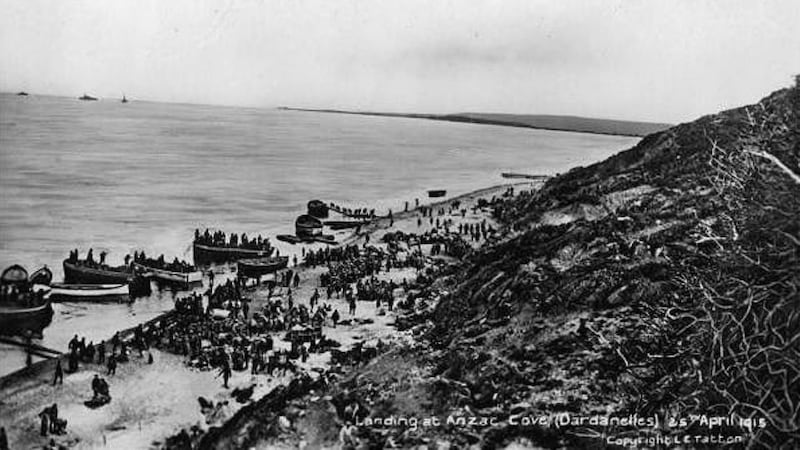Güral’s place has a neo-hippy feel about it – sort of Alexander Selkirk meets Ken Kesey.
It is just about the last place on Suvla Point at the western end of the Gallipoli peninsula.
There’s stuff everywhere, the detritus of a life spent fishing out of small boats: bits of rope and chain and piles of fishing nets; car tyres used as buoys; plastic containers, used, reused and then used again; bits of metal (use unknown but probably vital); and tables and chairs – one lot under a vine-covered awning for family and friends, the other for visitors to Güral’s café, if that is not too grand a word to describe the set-up.

But on a bright sunny August day, Güral’s place seems like paradise on earth. To say it is relaxed would be to suggest a level of activity way beyond anything witnessed.
Güral’s makeshift harbour was fashioned by nature whittling away at the soft sandstone jutting into the sea. The slipway is lapped by the water of Suvla Bay, which in turn is shades of aquamarine, turquoise and cobalt – rich blues that deliver a sense of calm merely by looking at them.
I guess the hippy touch comes also in part from the tiny electricity-generating windmill whirring just above the large camper van parked beside Güral’s tiny seaside cottage home.
I sit in the shady spot clearly reserved for visitors and a woman, Güral’s wife I assume, comes to serve me. I ask for Turkish tea with lemon and take out my Gallipoli campaign military map to pour over the details.
Güral approaches with several framed photographs from the 1915 war. They show that the exact spot where we now are was then swarming with British soldiers and landing craft. There are two sunk just around the corner, Güral indicates.
Then he brings to the table a rusted military shell. It is about 10 inches long and very, very heavy for its size. British, he says.
Immediately inside Güral’s tiny cottage, to which he insists I come, is his bedroom, living room and kitchen all in one. You don’t need a lot of indoors when living in a climate like this.
Necklace of bullets
Hanging like a necklace across a corner of the room are half a dozen bullets strung together by a thread. There’s a small, three-bullet magazine clip on a shelf, all rusty but still recognisable for what it is, and lots of photos of Güral’s fishing trips with pals.
Outside again and drinking my tea, I am joined by Renato who comes from Novara in northern Italy. Renato is the owner of the camper van, it transpires. Despite running a factory that makes plastic bags, he also has that neo-hippy, extremely relaxed air about him. Maybe it is the T-shirt and holiday beard . . .
Renato ambled into Güral’s laid back world some years ago and, despite holidaying in many other places, he keeps coming back here. The fishing, he says.
He tells me how local children used to collect bits of scrap metal from the fields that back onto the shore, the fields fought over in 1915.
Renato is well travelled. He’s been to Afghanistan and Bosnia, and most places in between, in his camper van. He pulled into Travnik in Bosnia one time before the war there with a mechanical problem.
A bloke in a garage fixed it. “And so we drank a lot and fished a lot,” Renato says in that way continentals have when talking philosophy. “And when I go back [after the war], he gone. And now I don’t know his name. The war is crazy you know.”
Marta, Renato’s daughter joins us. She’s an anthropologist but works as a language teacher.
Bone in the sand
“I found a bone,” she announces, gesturing to the side of her abdomen, suggesting a rib.
“Yes. Over there.” She indicates the very end of Suvla Point. “There’s a small beach and I was swimming and I lifted the bone from the sand and they says here [in Güral’s] that it is human.”
Marta’s find occurred in 2006 and is not uncommon, says Güral. There are bits of the war everywhere – bullets, bullet casings, shells and bones.
The landings at Suvla, which involved, among others, the 10th Irish Division, occurred in August 1915 and were the final phase of fighting before Britain, France, Australia and New Zealand withdrew, defeated, between December 1915 and January 1916.
The place where it all happened is now so calm, so serene, so relaxed.
The Turks say they lost 8,155 men in their successful defence of Suvla and that their enemy lost 19,850.
One of them was 23-year-old Capt William George Massy Eagar, of the 1st battalion of the Royal Munster Fusiliers, who lived on Church Road in Greystones, Co Wicklow. He has no known grave but is remembered on the Helles Memorial.
He died 99 years ago last week, on August 21st 1915.












